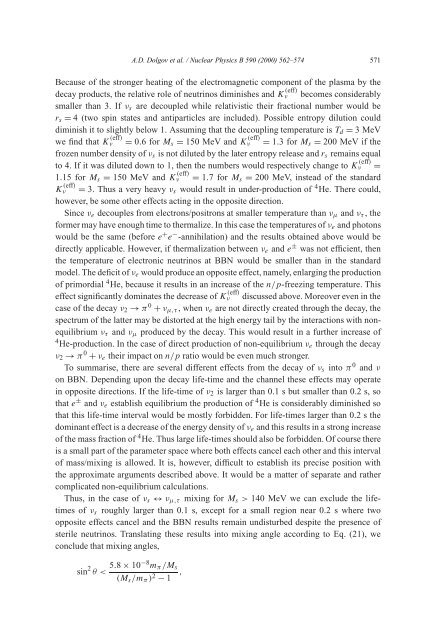Heavy sterile neutrinos - MPP Theory Group
Heavy sterile neutrinos - MPP Theory Group
Heavy sterile neutrinos - MPP Theory Group
You also want an ePaper? Increase the reach of your titles
YUMPU automatically turns print PDFs into web optimized ePapers that Google loves.
A.D. Dolgov et al. / Nuclear Physics B 590 (2000) 562–574 571<br />
Because of the stronger heating of the electromagnetic component of the plasma by the<br />
decay products, the relative role of <strong>neutrinos</strong> diminishes and K ν<br />
(eff) becomes considerably<br />
smaller than 3. If ν s are decoupled while relativistic their fractional number would be<br />
r s = 4 (two spin states and antiparticles are included). Possible entropy dilution could<br />
diminish it to slightly below 1. Assuming that the decoupling temperature is T d = 3MeV<br />
we find that K ν<br />
(eff) = 0.6 forM s = 150 MeV and K ν<br />
(eff) = 1.3 forM s = 200 MeV if the<br />
frozen number density of ν s is not diluted by the later entropy release and r s remains equal<br />
to 4. If it was diluted down to 1, then the numbers would respectively change to K ν (eff) =<br />
1.15 for M s = 150 MeV and K ν<br />
(eff) = 1.7 forM s = 200 MeV, instead of the standard<br />
= 3. Thus a very heavy ν s would result in under-production of 4 He. There could,<br />
K (eff)<br />
ν<br />
however, be some other effects acting in the opposite direction.<br />
Since ν e decouples from electrons/positrons at smaller temperature than ν µ and ν τ ,the<br />
former may have enough time to thermalize. In this case the temperatures of ν e and photons<br />
would be the same (before e + e − -annihilation) and the results obtained above would be<br />
directly applicable. However, if thermalization between ν e and e ± was not efficient, then<br />
the temperature of electronic <strong>neutrinos</strong> at BBN would be smaller than in the standard<br />
model. The deficit of ν e would produce an opposite effect, namely, enlarging the production<br />
of primordial 4 He, because it results in an increase of the n/p-freezing temperature. This<br />
discussed above. Moreover even in the<br />
case of the decay ν 2 → π 0 + ν µ,τ ,whenν e are not directly created through the decay, the<br />
spectrum of the latter may be distorted at the high energy tail by the interactions with nonequilibrium<br />
ν τ and ν µ produced by the decay. This would result in a further increase of<br />
4 He-production. In the case of direct production of non-equilibrium ν e through the decay<br />
ν 2 → π 0 + ν e their impact on n/p ratio would be even much stronger.<br />
To summarise, there are several different effects from the decay of ν s into π 0 and ν<br />
on BBN. Depending upon the decay life-time and the channel these effects may operate<br />
in opposite directions. If the life-time of ν 2 is larger than 0.1 s but smaller than 0.2 s, so<br />
that e ± and ν e establish equilibrium the production of 4 He is considerably diminished so<br />
that this life-time interval would be mostly forbidden. For life-times larger than 0.2 s the<br />
dominant effect is a decrease of the energy density of ν e and this results in a strong increase<br />
of the mass fraction of 4 He. Thus large life-times should also be forbidden. Of course there<br />
is a small part of the parameter space where both effects cancel each other and this interval<br />
of mass/mixing is allowed. It is, however, difficult to establish its precise position with<br />
the approximate arguments described above. It would be a matter of separate and rather<br />
complicated non-equilibrium calculations.<br />
Thus, in the case of ν s ↔ ν µ,τ mixing for M s > 140 MeV we can exclude the lifetimes<br />
of ν s roughly larger than 0.1 s, except for a small region near 0.2 s where two<br />
opposite effects cancel and the BBN results remain undisturbed despite the presence of<br />
<strong>sterile</strong> <strong>neutrinos</strong>. Translating these results into mixing angle according to Eq. (21), we<br />
conclude that mixing angles,<br />
effect significantly dominates the decrease of K (eff)<br />
ν<br />
sin 2 θ< 5.8 × 10−8 m π /M s<br />
(M s /m π ) 2 − 1 ,













